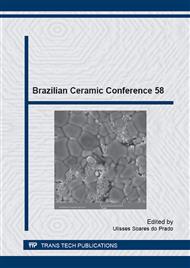p.315
p.320
p.325
p.330
p.335
p.341
p.349
p.355
p.361
Europium-Doped Hydroxyapatite: Influence of Excitation Wavelength on the Eu3+ Luminescence in the Hydroxyapatite
Abstract:
Hydroxyapatite (HA) doped with europium (HAEu) offers the advantage of making the hydroxyapatite a fluorescent biomarker, allowing their imaging through emission in vivo and in vitro tests. Several authors had been based their studies about europium site occupation (CaI and CaII) in hydroxyapatite by the lanthanide ion luminescence, verifying the influence of the method of synthesis and concentration of the dopant ion. In this study HA nanoparticles doped with 1.4 mol% of trivalent europium were synthesized by co-precipitation method and thermal treated at different temperatures (600°C and 1200°C). A careful evaluation of the influence of the excitation wavelength of europium luminescence in the HAEu was performed and it has been verified that both the characteristics transitions of europium, at CaI and CaII sites, and the luminescent intensity are dependent on the excitation wavelength. The non-observance of this fact can lead to erroneous conclusions about the site occupation of europium in hydroxyapatites.
Info:
Periodical:
Pages:
335-340
Citation:
Online since:
June 2015
Keywords:
Price:
Сopyright:
© 2015 Trans Tech Publications Ltd. All Rights Reserved
Share:
Citation:


